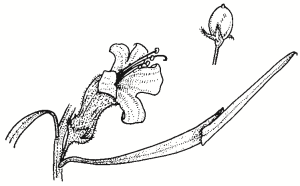Family:
Myoporaceae
Eremophila longifolia
Berrigan
Other Names: Emubush, Native Plum Tree.
First Nations Name(s):

Name Origin:
Eremophila — from Greek eremos, a desert, and philos, fond of, referring to dry country habitat.
longifolia — Latin for long-leaved.
Regional Subspecies:
Occurrence:
Regional:
Locally common in the west, including the areas: Urana- Rand-Corowa; Boree; Brookong and Urangeline.
Australia:
Mainland states and territories.
Habitat:
Various communities, including plains country, on most soil types. Mainly sandy or loam soils, in Grey Box, White Cypress Pine, Boree and Mallee communities.
Habit:
Shrub to small tree to 8 m high. Narrow drooping leaves 3-20 cm long on drooping branches. Mature bark dark-grey, rough and divided into squarish segments.
Site Preference:
Well-drained soil in full sun.
Characteristics:
Usually occurs as single trees or clumps of suckers of decreasing size out from parent tree.
Flowering:
Pinkish to reddish-brown and spotted white, most of year. Very attractive tubular flowers.
Seed Collection:
Early Jan to late Mar. Seeds released 3-14 days after maturity. Fruits can be collected from beneath plants.
Propagation:
From seed or stem or root cuttings. Most Eremophila species very difficult to germinate. Hard woody fruits prevent germination and contain chemical inhibitor. Stem cuttings can be very slow to root. Promote suckering by disturbing roots. Transplant resulting root suckers.
Regeneration:
Prolific, from seed and root suckers. Recovers well from fire, including juvenile plants. Best established by transplanting root suckers in moist conditions, or by fencing out stock and ripping to cause root suckering.
VALUES:
Shade & Shelter:
Excellent low-level cover in windbreaks.
Land Protection:
Useful in controlling soil erosion due to soil-binding fibrous roots.
Wildlife:
Excellent habitat. Emus eat fruit. Almost all Eremophila species are attractive to honeyeaters. Particularly useful bird attracter in drier areas. Beneficial nectar and pollen for bees.
Timber:
Dark brown and brittle. Not used.
First Nations:
Bruised leaves used for tanning skins. Reputed medicinal use.
Ornamental:
Ornamental for low garden shelter.
Other:
Probably the best Eremophila fodder species. Constantly trimmed by livestock, and sometimes used for emergency feed.
